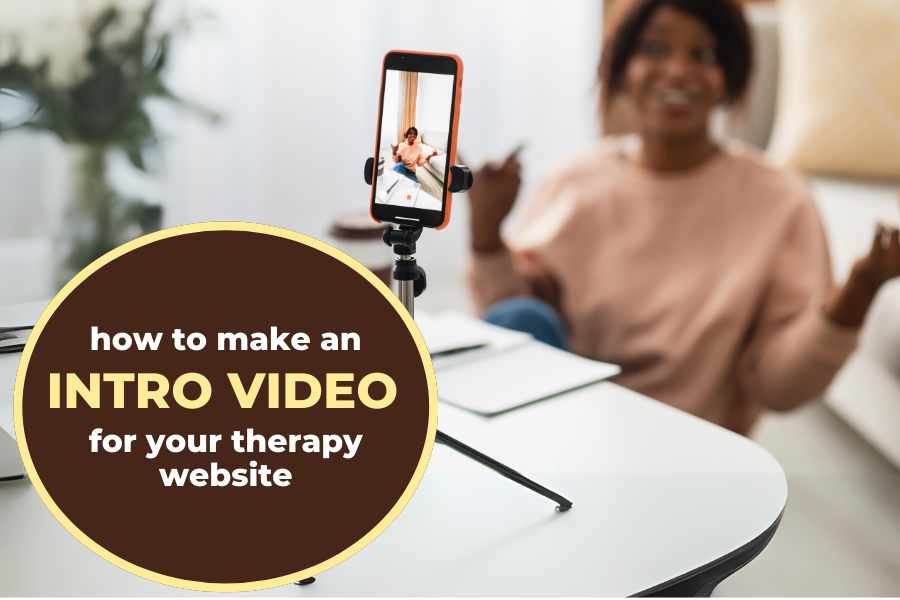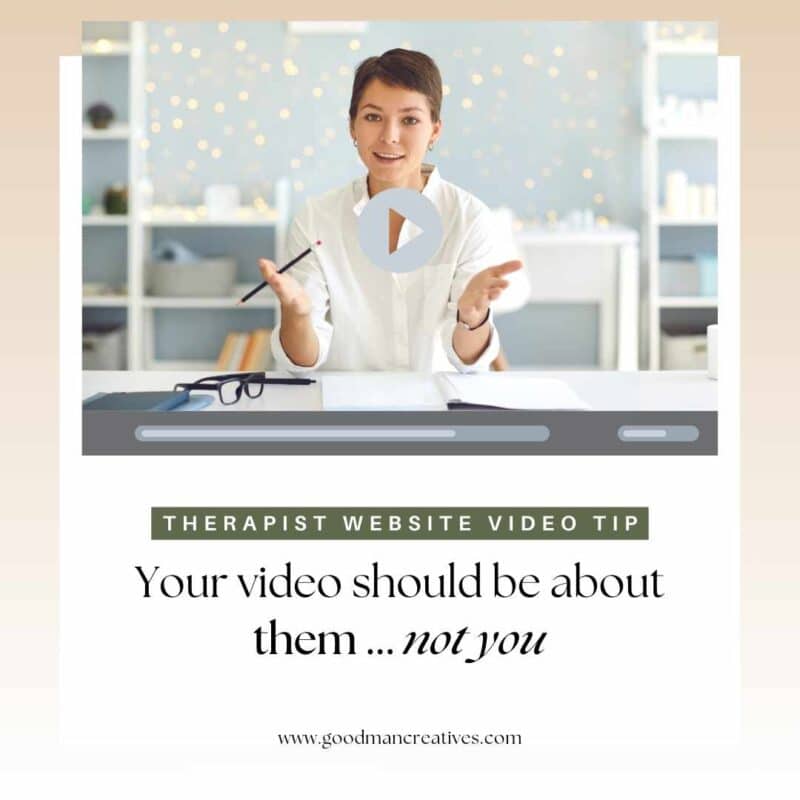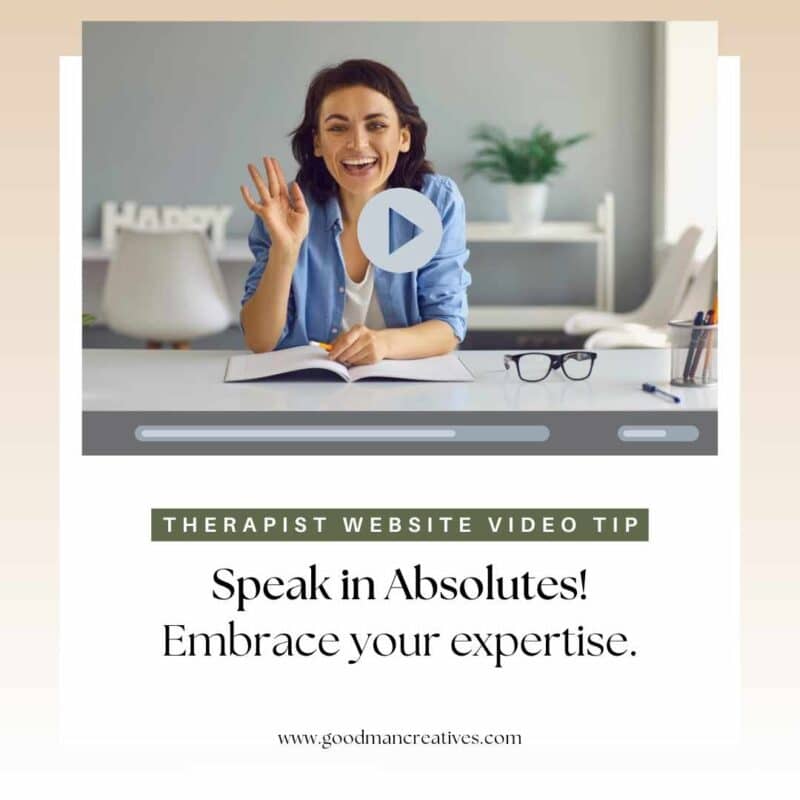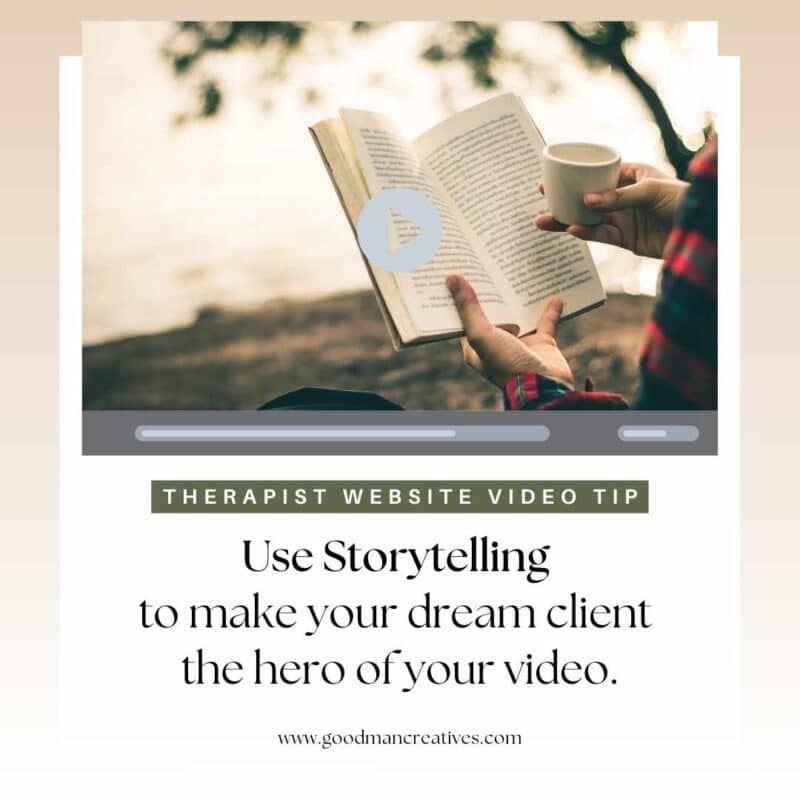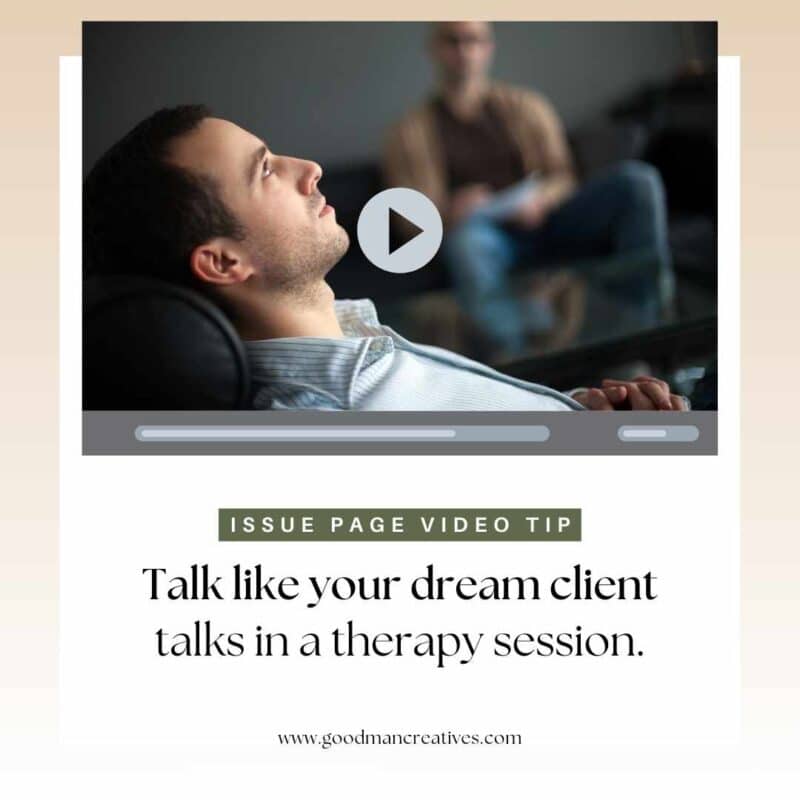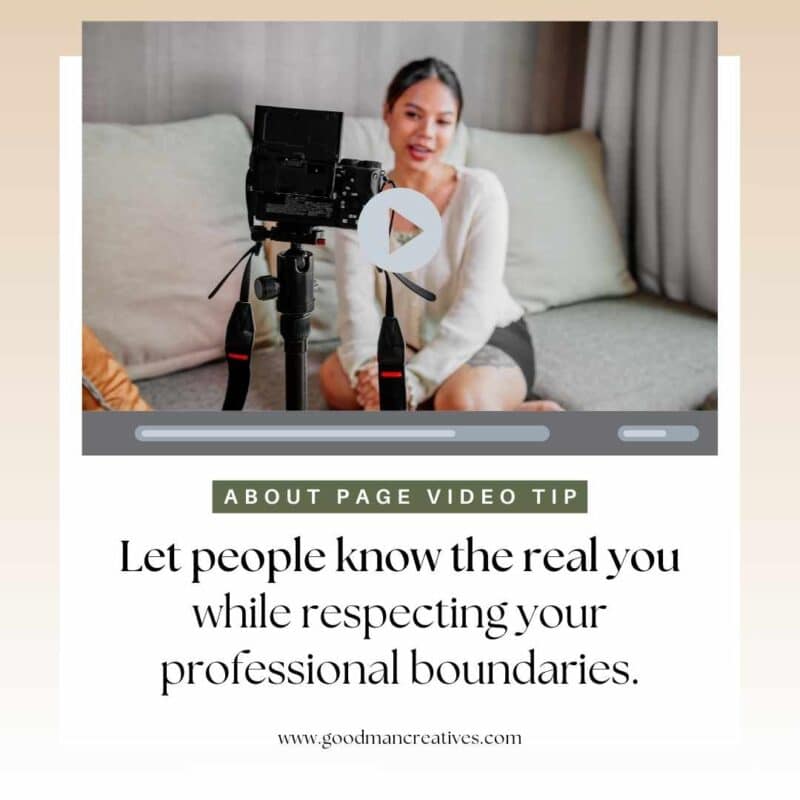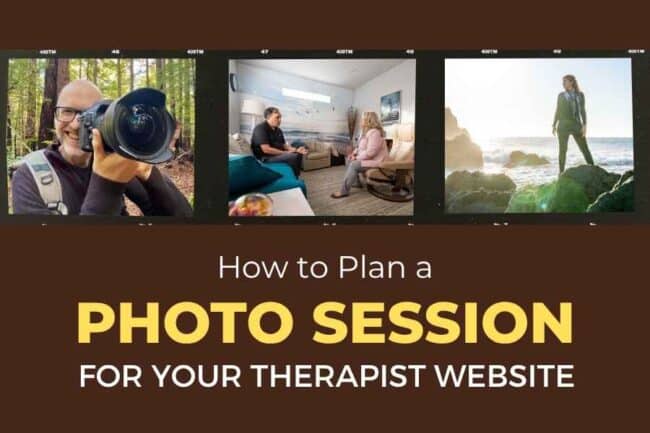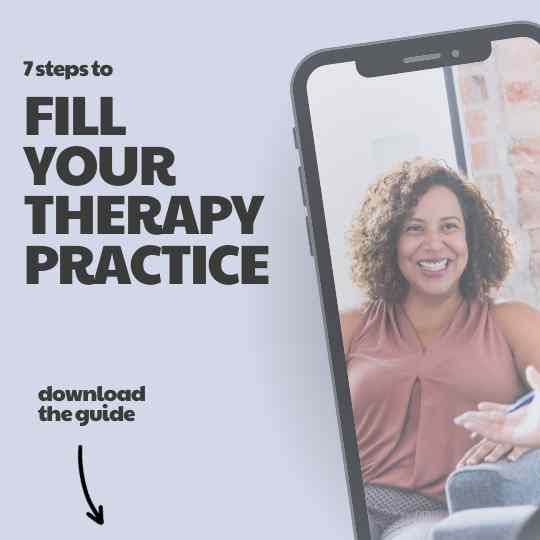Creating videos for your therapist website is essential for fostering a personal connection with your dream client.
Written words can’t convey the same level of warmth, empathy, and authenticity that a video can. Your dream client wants to hear your voice and get a sense of your personality, approach, and “bedside manner.” They want to know you understand their struggles and can provide the support they need. A video allows them to see and hear you, helping to build trust and reduce anxiety before they ever meet you. It conveys warmth, empathy, and professionalism all at once.
If incorporating video feels daunting, you are not alone. Most therapists I work with share some level of anxiety or trepidation around recording their website videos. However, if you are willing to work through your resistance, I’m here to guide you through creating different types of videos for your practice website. From your homepage introductory video to issue-specific content, I’ll help you gain clarity on what to include in each video … while offering a non-techy guide to the tech stuff.
Make the Video About Them, Not You
If you remember nothing else from this article, remember this … most people don’t care about your credentials, approach, personal journey, or anything else. They want to know “what’s in it for me?” and “does this person actually get me?”
Focus on showing empathy and understanding towards what your ideal clients are going through. Speak directly to their struggles. Use phrases that mirror their internal dialogue and validate their experiences. Keep the focus on them by avoiding too many “I” statements.
Here are a few examples of simple shifts you can make in your therapist website video:
Anxiety
❌ “I have extensive experience in treating anxiety.”
✅ “Living with anxiety can feel overwhelming. How are you supposed to calm down when your mind is always racing?!”
CBT
❌ “I am trained in Cognitive Behavioral Therapy (CBT).”
✅ “An analytical mind needs an analytical approach to therapy. Together, we will use evidence-based tools and practical strategies to improve your mood and regain control over your life.”
General Statements
❌ “I offer an integrative approach to your treatment.”
✅ “We will customize your therapy experience to best meet your needs and goals, drawing from a variety of tools and techniques.”
By focusing on their experiences, you demonstrate that you truly understand their pain points. This approach not only builds trust but also positions you as a compassionate ally in their journey towards healing.
Remember, creating a video on your practice website is about making your dream client feel seen, heard, and understood. The more you connect with them on an emotional level, the more likely they are to feel comfortable reaching out to you for help.
Speak in Absolutes Rather Than Guessing with “You” Statements
When speaking to your dream client, clarity and confidence are key. Instead of guessing their experiences with “you” statements, speak in absolutes. This technique helps build trust and authority, showing that you deeply understand their struggles without making it sound like a guess.
Honest question though … how do you feel about that? Many therapists I work with struggle with the idea of speaking in absolutes out of fear of being too assertive. They tell me, “my therapy sessions are collaborative. I believe my clients are the experts of their own lives. I don’t tell them what to do.”
Sound familiar? Therapists often avoid making bold statements in their marketing, which might come across as arrogant or too assertive. Yet, potential clients want to know you understand their struggles and have the confidence to help them.
You are an authority.
Let that sink in.
Even if your therapy style is more collaborative, there’s a difference between therapist marketing and therapy. Instead of guessing their experiences with “you” statements, speak in absolutes. This technique helps build trust and authority, showing that you deeply understand their struggles without making it sound like a guess. It also helps you stand out in a busy online therapist world, where the average therapy-seeker is visiting at least 5 practice websites before making a decision.
If you’re saying to yourself, “But that’s not me,” here’s a reframe.
Your approach to video recording and copywriting does NOT have to match your therapy style. Sure, you want a consistent experience between your marketing and your sessions. But no one is going to quit therapy because you used direct statements on your website video and then shifted to a “you are the expert of your own life” approach during therapy sessions. All they will remember is how you make them feel in the moment.
How to be assertive yet authentic
Here are a few examples of how you can shift the narrative when recording videos for your therapy practice website. Take note of how each one removes the ambiguity and speaks directly to the core of someone’s experience without being overly aggressive.
Stress
❌ “You might be feeling overwhelmed by stress.”
✅ “Stress is overwhelming.”
Anxiety
❌ “Are you finding it difficult to concentrate?”
✅ “Concentration is challenging when your mind is always thinking about what comes next.”
General Statements
❌ “Have you ever felt isolated in your struggles?”
✅ “You are not alone in your struggles … even though it may feel that way sometimes.”
Use Storytelling in Your Therapist Website Video
Storytelling is one of the most powerful tools you have at your disposal. When done right, it can captivate your dream client and make them feel understood and hopeful. The key is to make your website visitors the hero of the story while positioning yourself as the guide who helps them navigate their journey from struggling to thriving. I personally love the Storybrand framework.
Here’s how to incorporate storytelling when making videos for your therapist website:
1. Identify the Hero (Your Client)
Start by clearly identifying your ideal clients’ struggles. Speak to their pain points and current challenges. This shows that you understand their situation deeply.
2. Set the Scene
Describe the context of their struggles. Use vivid imagery and relatable scenarios to paint a picture of their daily life. This helps the viewer see themselves in the story.
3. Present the Guide (You)
Introduce yourself as the guide who has the knowledge, tools, and experience to help them. Emphasize that you are here to support them on their journey.
4. Define the Goal
Clearly articulate the desired outcome. What does success look like for your client? Whether it’s managing anxiety, overcoming depression, or improving relationships, paint a picture of a better future.
5. Outline the Plan
Give them a simple, clear plan. Explain how your therapy process works and what steps you will take together to reach their goal. This reassures them that there is a structured path forward.
6. Call to Action
End with a strong call to action. Encourage them to take the next step, whether it’s scheduling a consultation, signing up for a newsletter, or starting therapy sessions. Make it clear how they can begin their journey with you.
Example of Storytelling in a Therapist Video About Anxiety
Instead of simply saying, “I can help you manage your anxiety,” tell a story. Here’s an exact script you can use as a starting point:
“Another restless night. Another morning of worry. Will there be traffic? Am I ready for that presentation? My partner didn’t kiss me goodbye today – what did I do wrong? He must be mad at me. What did I do wrong?
Work doesn’t offer a reprise either. I messed up that report. The boss likes everyone else more than me. I hope no one realizes how bad I am at this.
Sound familiar?
Living with anxiety feels like you’re constantly on edge, waiting for the next shoe to drop. Every day is a struggle and your mind just won’t turn off … no matter how much you want it to. But, it doesn’t have to be this way. Imagine having confidence in your decicions and your relationships. What would change if you stopped doubting your abilities and actually lived up to your full potential at work?
I’ve helped many people just like you find practical strategies to manage their anxiety and reclaim their lives. Together, we’ll create a plan tailored to your unique challenges and goals. Take the first step today towards a more peaceful, fulfilling life.”
By positioning your client as the hero and yourself as the guide, you empower them and create a narrative that is both compelling and reassuring. This storytelling approach not only makes your message more engaging but also builds a deeper, emotional, and instant connection, making potential clients more likely to reach out for your help.
Prepare Before Recording Your Website Video
Do you like to “wing it?” Or, are you the type of person who wants to plan and practice before clicking record? There is no right answer. But, if you’re like most people, you’ll need a little prep time to make sure all videos for your therapist website reflects your authentic self.
Here’s how to get ready for recording: from writing your script to rehearsing and mentally preparing yourself for a genuine, engaging presentation.
1. Write a Script
- Use an Outline — The specific parts of your outline will vary depending on what page your video will appear on. Use bullet points to make your life easier. You can find my outline suggestions later in this article.
- Be Relatable — Use language that mirrors your client’s internal dialogue. Show empathy and understanding, and avoid overloading the script with “I” statements. Focus on their experiences and needs.
- Keep it Punchy — Length is less important than how concise you make it feel. Try to use as few words a possible for every topic you want to cover. This keeps the viewer’s attention and ensures your message is clear and direct.
- Sound Like Yourself — Write your script as you would actually speak. Put in your expressions and mannerisms. Embrace all that makes you YOU. If your script is too polished, it comes across feeling cold and impersonal.
2. Rehearse
- Practice on Video — Record yourself a few times to get a feel for how you come across on camera. Watch these recordings to see how your words and expressions translate on screen.
- Make Adjustments — Edit your script based on your practice sessions. Pay attention to any parts that feel awkward or unnatural, and tweak them for better flow and clarity.
- Embrace Imperfection — Remember, a few “ums” or natural pauses can make you seem more approachable. Aim for authenticity rather than perfection. Overly polished videos can sometimes feel unapproachable.
3. Get Mentally Ready
- Trust Your Instincts — Know that whatever you create will be perfect for connecting with your dream client. Your authenticity is your greatest asset.
- Stay Relaxed — Take a few deep breaths before recording. Remember that this is just a conversation with someone who needs your help.
- Visualize Success — Picture your dream client watching the video and feeling understood and hopeful. This mindset can help you present with confidence and warmth.
By following these steps, you’ll create a script that not only conveys your message effectively but also resonates deeply with your dream client and niche. Your video will come across as genuine, compassionate, and professional, helping to build that crucial first connection.
Use This Outline For Your Therapy Website Videos
In this section, I break down my suggested flow and format for each of your practice website’s core pages. Yes, there are subtle differences between your homepage, issues pages, and modalities pages. However, with the exception of your about page video, you should safely be able to follow this formula:
1. Remind them what their life is like.
Engage the viewer with a strong opening that captures attention. Use their words to paint a vivid picture and describe their daily struggles in detail. Don’t just say “if you are struggling with stress, anxiety, or depression …” Use empathetic language and give real world examples of how their struggles show up in their daily life.
2. Describe their dream outcome.
What would life look like if POOF, their issues suddenly went away? Often, your dream client can’t even imagine what this could be like. You get to help them envision a better future. This might include feeling more in control, reducing anxiety, or improving relationships. It could be a raise at work, a more fulfilling sex life, or an end to a lifetime of trauma-induced night terrors. Here are a few tips:
- Think about what positive changes your previous clients have experienced.
- Use positive, hopeful language to describe what life could look like after therapy.
- Casually mention that you have helped others get there before
3. Share an at-home exercise (optional).
How can you make someone’s life better … even if they never become a paying client. I truly believe that mantra is the way to have a successful business. These are the words I live by (hence this 6,000 word article that I’m sharing for the world for free).
As a therapist, offering an at-home exercise is the most powerful way to give someone a little preview of your style while also helping give them even a moment of relief. While adding this to your video will certainly make it longer, it will also build trust and I highly recommend it. Here’s the flow:
- Introduce the Exercise: Explain the purpose of the exercise and how it can help with their specific issue.
- Demonstrate the Steps: Pretend like it’s a therapy session … but remember to keep it as short as possible.
- Reiterate the Benefits: Remind them of the positive outcomes they can achieve by regularly practicing this exercise.
4. Introduce yourself as their guide.
Now that you have their trust, it’s time to introduce yourself. Give a few key facts, but don’t dive into the details. Here are a few ideas:
- How long have you been in practice (assuming you’ve been around for a while).
- Do you offer online or in-person therapy?
- What do you love most about being a therapist?
- What advanced credentials do you have? (just list 1-3)
- What unique approach do you bring to therapy?
- Share a brief success story to illustrate the positive impact you’ve had on others’ lives.
- Emphasize your dedication to supporting your clients on their journey.
Remember, the viewer (aka, your dream client) is the hero of your website and your website video. You are the compassionate guide who will get them to where you just told them was possible in step 2. They are Luke Skywalker. You are Obi Wan or Yoda (your choice).
5. End with a strong CTA (Call to Action).
End your therapist practice intro video with a strong call to action. Encourage them to take the next step, such as scheduling a free consultation or reaching out to you. Make it as easy as possible by telling them exactly how. For example, you could say “Just click the button below to schedule a free consult.”
Homepage Intro Video Suggestions
Suggested Length = 30-60 seconds
Your intro video to your website is the first impression many potential clients will have of you. This video should be a general overview that speaks directly to your dream client, showing them that you understand their struggles and can help them.
Since this is your homepage video, you’ll want to be a bit more general. Rather than focusing on a specific issue (unless that’s all you treat), think about how your dream client’s life is off-kilter in relationships, work, and self. Going too micro here means your ideal client might not watch an entire video.
Power Tip — whatever you record for your homepage is also going to work great for your Psychology Today video.
Example Therapist Homepage Video Script
“Life can be exhausting. Overwhelming. Challenging. How can you stay positive when it feels like nothing is going the way you want it to? Do your friends and family even know what’s going on behind the scenes? What do you even want life to look like?
How would things be different if you were able to hear your thoughts without letting them control you? What would you do differently if you weren’t always worried? Wouldn’t it be nice to have the tools you need to wake up feeling calm and in control, ready to face whatever the day brings?
My name is Greg Goodman and I’ve been helping people just like you for 23 years and counting. My methods include CBT therapy and Jungian Psychology, which means we dive deep into your subconscious to discover what’s causing you to feel the way you do … then, we use practical journaling and talk exercises to create a new reality in your mind and life.
Your therapy sessions can be held online from anyhere in California. Or, we can meet in person at my office in Santa Cruz.
If you’re ready to go on this journey together, the next step is to reach out and schedule a free phone consultation. Just click the button below to find a time that works for you.”
Issue Page Video — (Anxiety, Depression Trauma, etc.)
Suggested Length = 30 seconds – 2 minutes
Your issues pages are a chance to go into far more depth than your homepage video. Instead of macro, you get to focus on micro. How does that specific issue show up in their daily life? What does anxiety actually feel like? The goal here is to provide a more targeted and detailed narrative that resonates even more profoundly with clients who are seeking help for that specific concern.
Just as with the homepage, you want to focus on the issue as it relates to their life experience. Avoid jargon and diagnosis. Think about what people actually say in session. How does anxiety, depression, ADHD, phobias, etc. manifest in their daily life? What do these struggles keep your dream client from doing? Remind them why they are searching for a therapist in the first place. That’s the sweet spot for getting someone to watch an entire video.
Example Depression Page Video Script
“Life can feel like a never-ending battle when you’re struggling with depression. Simple tasks become monumental challenges. How can you find joy when it feels like a dark cloud is constantly hanging over you?
First, take a moment to celebrate the small victories. Some days, just getting out of bed is an accomplishment. Next, imagine a life where you consistently have the energy and desire to engage with the world. Yes, everyone wants to be happy. But, no one is happy all the time. Instead, our goal is to get you to a realistic place of balanced emotions. No more seesaw of ups and downs.
I’m [Your Name], and for over [X] years, I’ve been helping high achieving professionals overcome the grip of depression. Through a blend of compassionate listening and evidence-based practices like Emotionally Focused Therapy (EFT), we’ll work together to uncover the roots of your depression and develop practical tools to manage and alleviate your symptoms. My approach is tailored to meet your unique needs, ensuring that each step we take is meaningful and impactful.
Oh, and in case you were wondering, I offer online therapy across [X state] and in-person at my office in [X city].
Here’s a quick example of something you can do the next time you’re feeling depressed … and you can do it anywhere.
Close your eyes and take a deep breath. Focus on a place where you feel safe and calm. It could be a beach, a forest, or even a cozy room. Spend 30 seconds visualizing this place in detail, from the sounds to the smells. Open your eyes and check in with yourself. Do you still feel the same level of heaviness? Or, has your mood shifted in some way? Repeat as neeeded.
As for the next steps … if you’re ready to dive in and reclaim your life, reach out and schedule a free consultation. There’s a button below this video. Just click it and you’ll be taken to my online calendar to find a time that works for you. Hope to hear from you!”
Modality (How) Page Video — (CBT, EMDR, EFT, Couples Counseling, etc.)
Suggested Length = 30 seconds – 2 minutes
If someone is on one of your “how” pages, odds are they want to learn more about the specific modality that you use. Similar to the other videos for your therapist website, you want to remind the viewer why they are on your website. However, after reminding them, you want to frame the solution through the lens of the specific method you use.
Sample Flow For a Therapist Modality Page Video:
- Begin with a macro overview, since you’re not 100% sure what issue brought them to your modality page.
- Share how your modality can help treat the specific issues you just mentioned.
- Give a brief, non-technical overview of how the modality works.
- Mention where you provide therapy (online these cities and states, in person at your office in XYZ, etc).
- Provide a sample “at-home exercise” that gives the viewer a taste of what they can expect. It should be short and easy.
- Introduce yourself and your background.
- End with a strong CTA
Example EMDR Therapy Page Video Script
“Life can be filled with overwhelming challenges and lingering pain from past experiences … even if you don’t remember them. Whether you’re dealing with anxiety, trauma, or other emotional difficulties, it can feel like you’re stuck in a loop, unable to move forward. Imagine breaking free from these cycles and finding a sense of peace and resilience. Then, imagine doing all that without having to consciously relive the trauma.
Eye Movement Desensitization and Reprocessing (EMDR) is designed to help you process and heal from past traumas and distressing life experiences. It works by using guided eye movements to help your brain reprocess traumatic memories, reducing their emotional impact and helping you build healthier coping mechanisms.
Here’s a quick exercise to give you a taste of what EMDR can offer. Close your eyes and take a deep breath. Picture a peaceful place where you feel completely safe and relaxed. As you visualize this place, slowly move your eyes from left to right. Continue this for about 30 seconds. Open your eyes and notice any changes in how you feel. This simple exercise can help you start to shift your emotional state.
I’m [Your Name], and for over [X] years, I’ve been helping people just like you heal from trauma and find their way to a healthier, happier life through EMDR therapy. I offer online sessions across [X state] and in-person at my office in [X city]. My approach is compassionate and tailored to your unique needs … and I will never push you past where you are ready to go.
If you’re ready to explore how EMDR can help you move past your pain and reclaim your life, reach out and schedule a free consultation. Just click the button below to find a time that works for you. I look forward to helping you on this journey.”
About Page Video
Finally – a video that gets to be all about YOU. At least, it’s about you through the lens of what matters to your dream client. So in many ways, it’s still about them. Confusing? It doesn’t have to be.
The psychology behind your therapist about page video is simple: people are more likely to engage with someone they feel they know and can trust. By sharing your personal story and motivations, you create an emotional connection that sets the foundation for a strong therapeutic relationship. This initial connection can significantly reduce the anxiety and hesitation potential clients may feel about reaching out for help.
However, it’s important to listen to your own internal compass regarding how much to share. Your disclosure policy for the video should align with what you practice in sessions, ensuring consistency and authenticity.
Sample Flow For a Therapist About Page Video:
- Say Hi — Introduce yourself by name and casually mention your license and how many years you have been in practice. This should be very short – “My name is Greg Goodman and I’ve been a licensed Marriage and Family Therapist since 2006.”
- Personal Story and Motivation — Briefly share what inspired you to become a therapist. How did your life experience shape your approach to therapy?
- Why You Love Being a Therapist —Share what you find most rewarding about your work. Mention specific transformations or achievements of your clients that inspire you.
- Approach to Therapy — What is your “bedside manner?” Go into some detail about how you create a supportive and non-judgemental environment. Emphasize the unique aspects of your therapeutic style. What makes you you?
- Specializations — Briefly list out who you help (individuals, couples, families, high achieving professionals, etc.), the specific modalities you use (EMDR, CBT, IFS, etc.), and any issues you focus on (anxiety, depression, trauma, etc.). Avoid the temptation to go into depth. If they want to learn more about any of that, they will go to that specific page. You can even say that in your video. “To learn more about my approach to any of these things, check out that page on my website. There’s even a video there going into more detail.”
- Service Availability — Just the facts … online, in person, a mix of both, and where specifically. City, state, etc.
- CTA — Tell them exactly what to do next. “Click the button below to schedule a free phone consult.”
- Closing Remarks — Reiterate your commitment to supporting them. End on a positive and welcoming note, reaffirming that you are there to guide them on their journey.
Example About Page Video Script
“Hi, my name is [Your Name], and I’ve been a licensed [Your Credentials] since [Year].
Growing up, I faced my own set of challenges that often felt overwhelming. I struggled with anxiety and self-doubt, and it wasn’t until I found a compassionate therapist that I began to understand myself better and see the potential for change. Those transformative sessions inspired me to pursue a career in therapy, with the hope of helping others navigate their own struggles and find their path to healing.
What I love most about being a therapist is witnessing the incredible transformations my clients achieve. For instance, I had a client who came in feeling completely overwhelmed by anxiety. He couldn’t turn his mind off and was struggling at work and in his marriage. Through our work together, he learned how to peacefully co-exist with his internal monologue, listen more effectively, and communicate clearly with his wife. Oh, and he was also promoted to manager of his firm. Seeing my clients grow and thrive is what drives me every day.
My approach to therapy is centered around creating a supportive and non-judgmental environment. I believe in a collaborative approach, where we work together to identify your goals and create a personalized plan to achieve them. My therapeutic style is compassionate and empathetic, ensuring that each session is meaningful and impactful. I strive to make my clients feel safe, heard, and understood, providing a space where they can explore their thoughts and feelings without fear of judgment.
I specialize in helping individuals, couples, and families. My practice incorporates various modalities such as EMDR, CBT, and IFS, and I focus on issues like anxiety, depression, and trauma. If you’d like to learn more about any of these approaches, check out the dedicated pages on my website. There’s even a video there going into more detail.
I offer both online and in-person therapy sessions to accommodate your needs. Whether you’re located anywhere in [State/Country] or prefer the comfort of your home, we can work together to find a solution that fits your lifestyle.
If you’re ready to take the first step towards a better life, I’d love to hear from you. Click the button below to schedule a free phone consultation, and let’s begin this journey together.
Remember, you are the hero of your story, and I’m here to guide you every step of the way. I look forward to supporting you on your path to healing and growth.”
Technical Aspects of Recording a Video
Creating a professional and engaging video for your therapist website involves more than just what you say … it also depends on how you present it. High-quality video and audio can significantly enhance your viewer’s experience and help convey your message more effectively. Meanwhile, a poorly filmed means you risk losing someone’s attention and ensures they will not want to keep viewing your video. Here are some key technical aspects to consider:
Lighting
Lighting is one of the most critical elements of a good video. Natural light is your best friend; position yourself facing a window to utilize soft, natural light, which will illuminate your face evenly. However, avoid direct sunlight on your face as it can create harsh shadows and make you squint. If natural light isn’t an option, use soft, diffused lighting to eliminate shadows and create a flattering look. Ring lights or softbox lights are excellent choices for even illumination. Remember to avoid using overhead lights as they can cast unflattering shadows on your face. Have fun setting up your lighting technology.
Technology Recommendation
- Ring Light.
- Softbox Lighting Kit (this is what I use for my videos)
Sound
Sound quality is equally important. Invest in an external microphone such as a lavalier, shotgun, or USB mic, which provides much clearer audio than built-in phone or camera microphones. Position the microphone close to you to capture your voice clearly and reduce background noise. Ensure you’re recording in a quiet space free from background noise. Close windows, turn off fans, and inform others that you’re recording to minimize interruptions. Soft furnishings like carpets, curtains, and cushions can help absorb sound and reduce echo.
Technology Recommendation
Phone vs. Pro Camera
As for a video recorder, modern smartphones can produce high-quality videos on your website. Use a tripod or stabilizer to keep your footage steady and ensure you’re recording in HD or 4K settings to maximize video quality. A professional camera offers higher video quality and more control over settings like focus and exposure. It’s a bigger investment and requires more setup but can significantly enhance your video’s overall look.
Depth of Field
Creating depth in your video recorder can help keep the focus on you. Use Portrait Mode on an iPhone to achieve a blurred background effect. Position yourself away from the background to create this depth naturally. If you’re using a professional camera, use a lens with a wide aperture (e.g., f/1.8) for shallow depth of field. Position the camera further from the subject and zoom in to enhance this effect.
Recording Orientation
Always record in horizontal (landscape) mode for a professional look. Horizontal video is more versatile and widely accepted on various platforms. It ensures that your video fits well on different screens, from mobile phones to desktop computers and other sizes of technology.
Editing
While video editing isn’t always necessary, it can enhance your video’s professionalism. Basic editing tips include trimming unnecessary parts, adding captions and titles for clarity, and adjusting brightness, contrast, and sound levels. Free software options like iMovie, Shotcut, and DaVinci Resolve, or paid options like Adobe Premiere Pro and Final Cut Pro, can help you polish your video.
Additional Tips
- Background — You should film in the same place where you offer online (or in-person) therapy. Make sure the background is clean and uncluttered to keep the focus on you. Do a sweep for errant papers, open doors and closets, or anything else that could be distracting.
- Framing — Position yourself in the center of the frame with adequate headroom. Ideally, you should be able to see below the shoulders so it doesn’t look like your hands just randomly float into the frame.
- Body Language — How do you want to come across? Serious? Friendly? Think about all the nuances you notice in the body language of your clients and use that to guide your video content.
- Clothing — Wear solid colors and avoid busy patterns. Ensure your clothing contrasts with the background to make you stand out.
Stop Reading and Go Record Your First Video
Hopefully, you now understand just how important video is in creating a connection with your dream client. It’s about more than just sharing information … it’s about showing your warmth, empathy, and authenticity. Your dream client wants to feel understood and see the genuine person behind the professional title.
I know making videos for your therapist website can feel intimidating. But remember why you’re doing this: to reach those who need your help, to build trust, and to show that you genuinely understand their struggles. Imperfection is your ally here. Authenticity shines through the small imperfections, making you more relatable and human.
So, stop reading. Take out your phone right now and record the first thing that comes to mind. Don’t worry about the background, sound, or technical details. Just talk from the heart. Share your passion for helping others and your commitment to their journey. Embrace the imperfections and let your true self shine through. No need to add the videos to your website. This is just for you.
Your clients are looking for someone they can connect with on a real, human level. By embracing authenticity, you’ll create a video that resonates deeply with them. You’ve got this. Now, go make that connection!
(and, if you actually do make that video, I would love to see it!)

